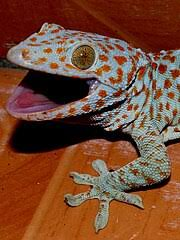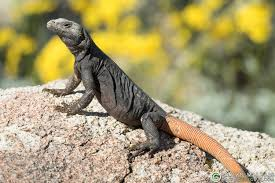
Lizard Name and Fact
| 1. Agama agama | 14 .Pogona vitticeps |
| 2. Anolis carolinensis | 15. Rhampholeon spectrum |
| 3. Ctenosaura pectinata | 16.Sauromalus ater |
| 4. Crotaphytus collaris | 17.Sceloporus undulatus |
| 5. Draco volans | 18 Sphenodon punctatus |
| 6. Eublepharis macularius | 19 Stenocercus crassicaudatus |
| 7. Gekko gecko | 20 Tiliqua scincoides |
| 8. Heloderma suspectum | 21 Urosaurus ornatus |
| 9. Iguana iguana | 22 Varanus komodoensis |
| 10. Lacerta agilis | 23 Varanus salvator |
| 11.Lemurian skink | 24 Varanus niloticus |
| 12.Montero’s Dragon | 25 Lygosoma bowringi |
| 13. Namibian Uromastyx | 26 Eumeces laticeps 27 Moloch horridus |
1. Agama agama (Common Agama)
Family: Agamidae
Habitat: Savannas, grasslands, and rocky areas in Africa
Diet: Insects, fruits, and flowers
Description: Known for its vibrant colors, especially in
males, and its adaptability to various habitats.

2. Anolis carolinensis (Green Anole)
Family: Dactyloidae
Habitat: Forests and gardens in the southeastern U.S.
Diet: Insects and spiders
Description: A small, arboreal lizard known for its
color-changing ability and its dewlap display.

3. Ctenosaura pectinata (Spiny-Tailed Iguana)
Family: Iguanidae
Habitat: Tropical dry forests and scrublands in Mexico
Diet: Fruits, leaves, and insects
Description: Recognizable by its spiny tail and robust body,
often seen basking in the sun.

4. Crotaphytus collaris (Collared Lizard)
Family: Crotaphytidae
Habitat: Arid and semi-arid regions of the southwestern
U.S. and northern Mexico
Diet: Insects, small vertebrates
Description: Known for its distinctive collar-like markings
around its neck and its ability to run on its hind legs.

5. Draco volans (Flying Dragon)
Family: Agamidae
Habitat: Forests and forest edges in Southeast Asia
Diet: Insects
Description: Famous for its wing-like flaps of skin that allow it to glide between trees.

6. Eublepharis macularius (Leopard Gecko)
Family: Eublepharidae
Habitat: Arid regions and rocky areas in Pakistan and India
Diet: Insects
Description: A popular pet due to its docile nature and
d
istinctive leopard-like spots.

7. Gekko gecko (Tokay Gecko)
Family: Gekkonidae
Habitat: Tropical forests and buildings in Southeast Asia
Diet: Insects and small vertebrates
Description: Known for its loud call and vibrant colors, with a large, robust body.

8. Heloderma suspectum (Gila Monster)
Family: Helodermatidae
Habitat: Arid regions of the southwestern U.S. and Mexico
Diet: Eggs, small mammals, and birds
Description: One of the few venom
ous lizards, recognizedby its bead-like skin and slow-moving nature.

9.Iguana iguana (Green Iguana)
Family: Iguanidae
Habitat: Rainforests and tropical areas in Central and
South America
Diet: Leaves, fruits, and flowers
Description: A large, arboreal lizard known for its
impressive size and long tail.

10. Lacerta agilis (Sand Lizard)
Family: Lacertidae
Habitat: Grasslands, heathlands, and sandy areas in Europe
Diet: Insects and spiders
Description: Characterized by its greenish coloration and
ability to dig into sandy soils.

11. Lemurian skink (Mabuya varia)
Family: Scincidae
Habitat: Forests and shrublands in Madagascar
Diet: Insects and small invertebrates
Description: Known for its smooth, shiny scales and fast-moving nature.

12. Montero’s Dragon (Ctenosaura pectinata)
Family: Iguanidae
Habitat: Arid and semi-arid areas in Central America
Diet: Fruits, leaves, and insects
Description: Recognizable by its spiny tail and robust build,
well-adapted to dry environments.

13. Namibian Uromastyx (Uromastyx (ornata))
Family: Agamidae
Habitat: Deserts and semi-arid regions of Namibia
Diet: Plants, seeds, and flowers
Description: Known for its large, spiny tail and striking
4color patterns.

14. Pogona vitticeps (Bearded Dragon)
Family: Agamidae
Habitat: Arid forests and scrublands in Australia
Diet: Insects, vegetables, and fruits
Description: Popular as a pet due to its calm temperament
and distinctive "beard" of spiked scales.

15. Rhampholeon spectrum (Spectral Pygmy Chameleon)
Family: Chamaeleonidae
Habitat: Moist forests in East Africa
Diet: Small insects
Description: A small, cryptic chameleon known for its vivid
colors and ability to blend into its surroundings.

16. Sauromalus ater (Common Chuckwalla)
Family: Iguanidae
Habitat: Arid regions and rocky areas in the southwestern U.S.
Diet: Plants, flowers, and fruits
Description: Recognizable by its large, rounded body and
ability to inflate its throat to deter predators.

17. Sceloporus undulatus (Undulate Spiny Lizard)
Family: Phrynosomatidae
Habitat: Rocky and shrubland areas in the southwestern
U.S.
Diet: Insects and spiders
Description: Known for its spiny texture and undulating
pattern along its back.

18. Sphenodon punctatus (Tuatara)
Family: Sphenodontidae
Habitat: Native to New Zealand’s offshore islands
Diet: Insects, small reptiles, and birds
Description: An ancient reptile with a unique "third eye"
and a lineage dating back to the dinosaurs.

19. Stenocercus crassicaudatus (fat-Tailed gecko)
Family: Tropiduridae
Habitat: Dry forests and rocky areas in South America
Diet: Insects and small invertebrates
Description: Known for its thick tail and robust build, adapted to dry, rocky environments.

20. Tiliqua scincoides (Blue-Tongue Skink)
Family: Scincidae
Habitat: Woodlands and grasslands in Australia
Diet: Insects, fruits, and vegetables
Description: Recognizable by its bright blue tongue, which
it displays as a defense mechanism.

21. Urosaurus ornatus (Ornate Tree Lizard)
Family: Phrynosomatidae
Habitat: Arid regions and deserts of the southwestern U.S.
Diet: Insects and small arthropods
Description: Known for its elaborate coloration and
behavior of climbing trees and shrubs.

22. Varanus komodoensis (Komodo Dragon)
Family: Varanidae
Habitat: Islands of Indonesia
Diet: Carrion, small mammals, and birds
Description: The largest living lizard, known for its
powerful bite and venomous saliva.

23. Varanus salvator (Water Monitor)
Family: Varanidae
Habitat: Wetlands and rivers in Southeast Asia
Diet: Fish, amphibians, and small mammals
Description: A large and agile monitor lizard known for its
swimming ability and opportunistic feeding habits.

24. Varanus niloticus (Nile Monitor)
Family: Varanidae
Habitat: Rivers, wetlands, and savannas in Africa
Diet: Fish, birds, and small mammals
Description: Known for its size and powerful limbs, often seen near water sources.

25. Lygosoma bowringi (Bowring’s Skink)
Family: Scincidae
Habitat: Forests and scrublands in Southeast Asia
Diet: Insects and small invertebrates
Description: A small, agile skink with smooth scales and a
burrowing lifestyle.

26. Eumeces laticeps (Broad-Headed Skink)
Family: Scincidae
Habitat: Forests and woodlands in the southeastern U.S.
Diet: Insects, spiders, and small invertebrates
Description: Known for its large head and striking color patterns

27. Moloch horridus (Thorny Devil)
Family: Agamidae
Habitat: Arid deserts of Australia
Diet: Ants
Description: Characterized by its spiny, thorn-covered body
and its ability to collect .